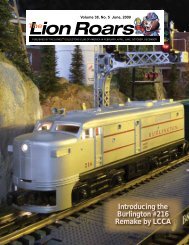Dec 2002 - Lionel Collectors Club of America
Dec 2002 - Lionel Collectors Club of America
Dec 2002 - Lionel Collectors Club of America
Create successful ePaper yourself
Turn your PDF publications into a flip-book with our unique Google optimized e-Paper software.
line with one <strong>of</strong> theleads to the standardgauge loop I was running.I did this because the oldpendulum E units need areal jolt to throw properly,and the type Ztransformer I used has noreverse button. And nomatter how fast my wristis, turning the dial to 0then back to 20 volts didnot operate at blindingelectronic speed. So Iinstalled the knife switch.It worked like a champ,until one day I opened theswitch and the train didn’tstop. Now clearly, thisshouldn’t happen. Therewas a _ inch gap in thewire connecting thetransformer to the tracks. It took a while, but I finally figuredit out. The station had shifted on the carpet and the base <strong>of</strong> thestation was making contact with the ties on the tracks. I hadput the knife switch in the common feed, not the hot side. Sothere were no gremlins in the basement, but it taught me to bemore careful about my wiring.Back to Figure 1. Starting from the left, there is a hotlead connected to the center rail <strong>of</strong> the tracks. That rail isinsulated from the center rail in front <strong>of</strong> the station. How longthis section is depends upon the trains you’re running. If theengine stops dead in its tracks (pun only semi-intended) whenthe current is interrupted, you don’t need too many insulatedsections <strong>of</strong> track. If it coasts, as some <strong>of</strong> the new equipmentwith flywheels, as well as much <strong>of</strong> the prewar equipmentwithout MagneTraction do, you’ll need more length to theinsulated section. But it will look far more realistic as it coaststo a stop with the passengers still standing instead<strong>of</strong> being knocked <strong>of</strong>f their feet by the sudden stopwith MagneTraction.Now follow that hot lead up and to the right.It’s going to two places. First, to the thin wirewrapped around the thicker section, second, to thethick section itself. The thick section is the bimetallicstrip. If you look at the end to the right, ithas an open contact above another thick strip whichis connected to the center, or hot, rail in the insulatedsection. Meanwhile, the thin wire coiling around itis the nichrome wire. Note that while it coils aroundthe bi-metallic strip, it doesn’t touch it: there is aninsulator between them. As you can see, this wireactually connects the center rail on the left to theinsulated center rail.Figure 1 Until a loco enters theinsulated sectionhowever, no currentflows, because there isnothing to draw current.Now go to Figure 2.When a loco enters thissection, current doesflow, but the resistance <strong>of</strong>the nichrome wire is tooFigure 2 high to allow enoughcurrent to pass to operatea loco motor. So whathappens when a locoenters the insulatedsection is that it stops:there isn’t enoughcurrent to keep it going.But there is a circuitcompleted from thecommon rails throughthe loco wheels, motor, and the pick-up, back through thenichrome wire to the hot section the loco just left. This causesthe nichrome wire to heat up, which, in turn, heats the bimetallicstrip. Since the two metals in the strip expanddifferently when heated, it bends, and closes the contact onthe top right in the sketch. This closes the circuit to the tracksvia the bi-metallic strip, which has far less resistance than thenichrome wire, so the loco starts up and pulls out <strong>of</strong> the station.Once the loco is gone, the circuit through the nichrome wireis opened, and it cools <strong>of</strong>f, cooling the bi-metallic strip, openingthe contact, and setting up everything for the next station stopsequence.Let’s look at the photos. Photo 1 shows the 127 and 137stations. The difference is the extra stuff hiding the lamp inthe 137 on the bottom. That’s the controller for the thermostatic25The Lion Roars <strong>Dec</strong>ember, <strong>2002</strong>
















